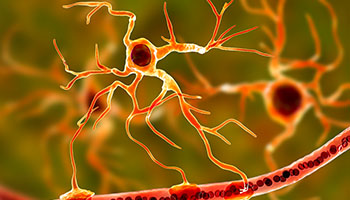HOW CAN WE HELP YOU? Call 1-800-TRY-CHOP
In This Section
What Role do Endothelial Cells Play in the Regulation of GLT-1 in Astrocytes?

Reciprocal communication between endothelial cells and astrocytes is necessary.
By Zila Martinez-Lozada
Editor’s note: Zila Martinez-Lozada, PhD, a postdoctoral fellow at CHOP in the lab of Michael B. Robinson, PhD, writes about a paper published in Neurochemistry International that describes a communication link between astrocytes and endothelial cells. Dr. Martinez-Lozada will be discussing this study and her current work at a Lunch and Learn session presented Jan. 21 by the CHOP Postdoctoral Alliance.
The findings:
Endothelial cells induce expression of the glutamate transporter 1 (GLT-1) in astrocytes through the Notch ligands Dll1 and Dll4. In addition, astrocytes induce expression of Dll4 in endothelial cells. Together, these findings indicate that reciprocal communication is required to induce maturation of astrocytes and endothelia.
Why it matters:
Astrocytes are a type of glial cell in the central nervous system, and one of their functions is to clear glutamate using glutamate transporters. The significance of these findings has two components. First, from the astrocytic point of view, this research advanced the understanding of GLT-1 regulation, and it identified the role of endothelia in this process. This could affect therapeutic efforts to treat diseases where excitotoxic damage is present after an insult to endothelial cells, such as stroke. In addition, the research advanced the understanding of astrocyte biology, particularly how endothelial cells dictate the fate of at least one of the main functions of astrocytes — the uptake of glutamate.
Second, from the endothelia point of view, the research uncovered that astrocytes signal to endothelial cells to stop angiogenesis and promote maturation of blood vessels. This could affect therapeutic efforts to treat diseases where there is abnormal angiogenesis, such as gliomas, and diseases that present with leakage of the blood brain barrier, such as Alzheimer’s disease.
Who conducted the study:
Zila Martinez-Lozada, PhD, postdoctoral fellow, and Michael B. Robinson, PhD, director of Neuroscience Research Affinity Group and the Intellectual and Developmental Disabilities Research Center at CHOP, and professor of Pediatrics and Systems Pharmacology & Translational Therapeutics at Perelman School of Medicine at University of Pennsylvania, led this research
How they did it:
The researchers used primary and co-cultures of astrocytes and endothelial cells, and then they used molecular approaches to identify the signaling pathway used by endothelial cells to communicate with astrocytes.
Quick thoughts:
“These results provide evidence that astrocytes and endothelial cells communicate with each other, which allows them to regulate their proteome accordingly,” Dr. Martinez-Lozada said.
What’s next:
The researchers are working on two projects. First, they are continuing to investigate the changes in the transcriptome of endothelia in response to co-culture with astrocytes. They are comparing the changes that endothelial cells induce in astrocytes vs. the changes induced by cortical neurons. Second, they are investigating a subpopulation of astrocytes during brain development.
Where was the study published:
The study appeared in Neurochemistry International.


